It’s a Cascade of 14nm CPUs: AnandTech’s Intel Core i9-10980XE Review
by Dr. Ian Cutress on November 25, 2019 9:00 AM ESTCPU Performance: Web and Legacy Tests
While more the focus of low-end and small form factor systems, web-based benchmarks are notoriously difficult to standardize. Modern web browsers are frequently updated, with no recourse to disable those updates, and as such there is difficulty in keeping a common platform. The fast paced nature of browser development means that version numbers (and performance) can change from week to week. Despite this, web tests are often a good measure of user experience: a lot of what most office work is today revolves around web applications, particularly email and office apps, but also interfaces and development environments. Our web tests include some of the industry standard tests, as well as a few popular but older tests.
We have also included our legacy benchmarks in this section, representing a stack of older code for popular benchmarks.
All of our benchmark results can also be found in our benchmark engine, Bench.
Speedometer 2: JavaScript Frameworks
Our newest web test is Speedometer 2, which is a accrued test over a series of javascript frameworks to do three simple things: built a list, enable each item in the list, and remove the list. All the frameworks implement the same visual cues, but obviously apply them from different coding angles.
Our test goes through the list of frameworks, and produces a final score indicative of ‘rpm’, one of the benchmarks internal metrics. We report this final score.
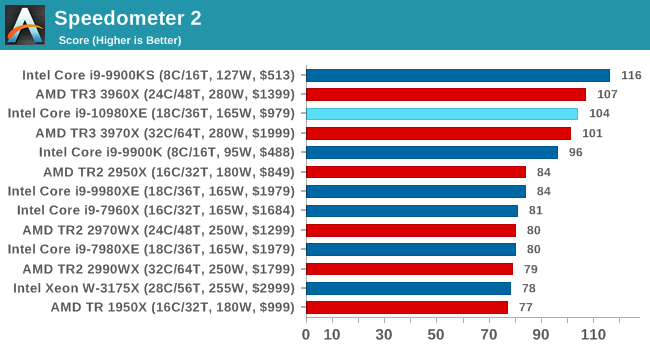
Google Octane 2.0: Core Web Compute
A popular web test for several years, but now no longer being updated, is Octane, developed by Google. Version 2.0 of the test performs the best part of two-dozen compute related tasks, such as regular expressions, cryptography, ray tracing, emulation, and Navier-Stokes physics calculations.
The test gives each sub-test a score and produces a geometric mean of the set as a final result. We run the full benchmark four times, and average the final results.

Mozilla Kraken 1.1: Core Web Compute
Even older than Octane is Kraken, this time developed by Mozilla. This is an older test that does similar computational mechanics, such as audio processing or image filtering. Kraken seems to produce a highly variable result depending on the browser version, as it is a test that is keenly optimized for.
The main benchmark runs through each of the sub-tests ten times and produces an average time to completion for each loop, given in milliseconds. We run the full benchmark four times and take an average of the time taken.
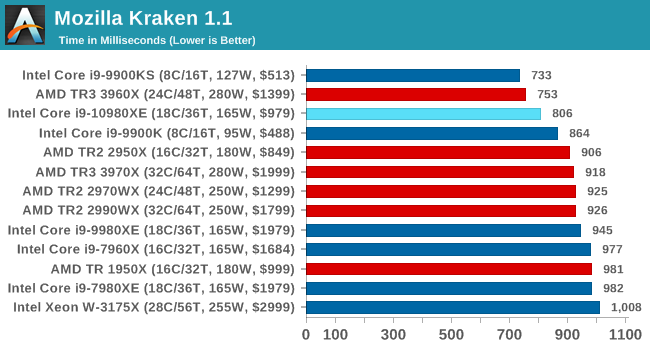
3DPM v1: Naïve Code Variant of 3DPM v2.1
The first legacy test in the suite is the first version of our 3DPM benchmark. This is the ultimate naïve version of the code, as if it was written by scientist with no knowledge of how computer hardware, compilers, or optimization works (which in fact, it was at the start). This represents a large body of scientific simulation out in the wild, where getting the answer is more important than it being fast (getting a result in 4 days is acceptable if it’s correct, rather than sending someone away for a year to learn to code and getting the result in 5 minutes).
In this version, the only real optimization was in the compiler flags (-O2, -fp:fast), compiling it in release mode, and enabling OpenMP in the main compute loops. The loops were not configured for function size, and one of the key slowdowns is false sharing in the cache. It also has long dependency chains based on the random number generation, which leads to relatively poor performance on specific compute microarchitectures.
3DPM v1 can be downloaded with our 3DPM v2 code here: 3DPMv2.1.rar (13.0 MB)
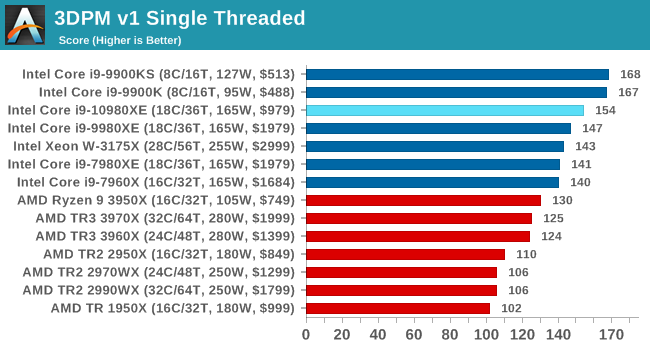
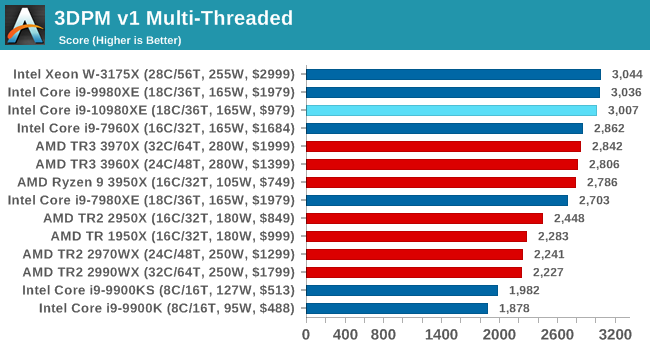
x264 HD 3.0: Older Transcode Test
This transcoding test is super old, and was used by Anand back in the day of Pentium 4 and Athlon II processors. Here a standardized 720p video is transcoded with a two-pass conversion, with the benchmark showing the frames-per-second of each pass. This benchmark is single-threaded, and between some micro-architectures we seem to actually hit an instructions-per-clock wall.
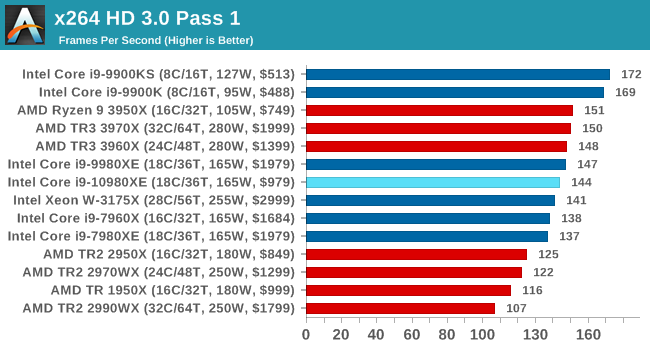
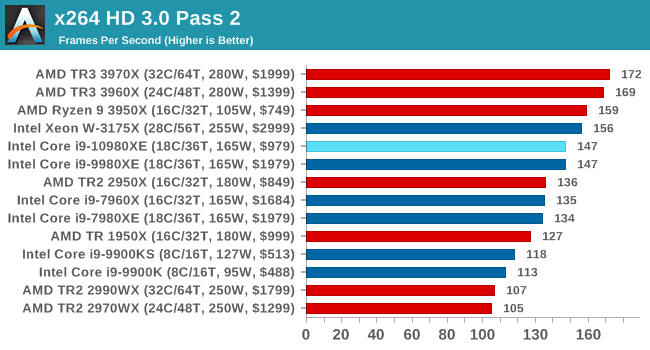
GeekBench4: Synthetics
A common tool for cross-platform testing between mobile, PC, and Mac, GeekBench 4 is an ultimate exercise in synthetic testing across a range of algorithms looking for peak throughput. Tests include encryption, compression, fast Fourier transform, memory operations, n-body physics, matrix operations, histogram manipulation, and HTML parsing.
I’m including this test due to popular demand, although the results do come across as overly synthetic, and a lot of users often put a lot of weight behind the test due to the fact that it is compiled across different platforms (although with different compilers).
We record the main subtest scores (Crypto, Integer, Floating Point, Memory) in our benchmark database, but for the review we post the overall single and multi-threaded results.
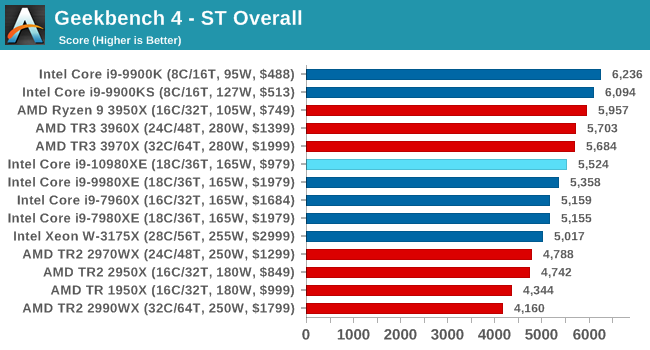










79 Comments
View All Comments
milkywayer - Monday, November 25, 2019 - link
Thank you AMD for strong arming the serial-milker Intel. Price cut from $1900 to $900. Hard to believe Intel would cut down on the core count milking. Am I dreaming?regsEx - Monday, November 25, 2019 - link
Mind it was Intel and without any competition who lowered mainstream price from $500 to $300 back in 2011. 3700X would cost $500 now if not that. So thank you, Intel.Spunjji - Monday, November 25, 2019 - link
Balderdash. Near the end of 2010 you could get a 6-core AMD Phenom II CPU for $270. By 2011, an "8 core" 4-module Bulldozer cost the same and Intel's products were priced to compete with that.So, uh, thanks again AMD..?
karmapop - Monday, November 25, 2019 - link
Sorry, but you may want to dig back into the review archives for some untinted perspective on that info. In fact, you're both incorrect. That mainstream performance pricing shift happened in 2008, with the introduction of the Yorkfield Core 2 Quad chips, and more importantly the Bloomfield Core i7 (with the i7-920 becoming that $300 darling entry point for the enthusiast platform).Those mid-2010 Thuban Phenom II X6 chips? Passably competitive with the lowest end quad-core Bloomfield chips (which were already on the market for a year and a half prior). And let's just forget about the dumpster fire that was Bulldozer, given that fabled FX-8150 had trouble matching the old Thuban Phenom II X6 at launch.
nt300 - Tuesday, November 26, 2019 - link
The FX 8350 & FX 8320 Piledriver CPUs saved AMDs bacon and proved to be more than enough for modern PC Gaming back in the day. They held great price/performance and were highly cost effective. Among Steamroller, then Excavator for the APU markets, they've held AMD afloat just in time for the superior ZEN launch. Now sit back and watch Intel finally struggle, deservingly so.yeeeeman - Wednesday, November 27, 2019 - link
They were so crap that AMD could boast 50% better ipc with zen over bulldozer, while still being lower than Skylake.Korguz - Wednesday, November 27, 2019 - link
too bad zen has better ipc then intel now...Gondalf - Wednesday, November 27, 2019 - link
According to the official Spec submissions nope, Zen 2 is on pair with Skylake (bypassing the huge L3). More or less AMD enlarged the L3 just to have the lead, this have a cost obviously, the 7nm silicon is pretty expensive. Try to image a 9900K with 32MB of L3 with the same latency.You will have a winner.
Korguz - Wednesday, November 27, 2019 - link
gondalfsorry but zen 2 does have better ipc then intel does now.. why else does intel need such high clocks to compete with lower clocked chips ?? explain that one.. clock for clock.. zen 2.. has better ipc...
Qasar - Wednesday, November 27, 2019 - link
gondalf : According to the official Spec submissions " what spec submissions page ? also.. if you think having a large L3 cache is the reason why zen has more ipc then intel, then there is something wrong. if that was the case, WHY didnt intel do the same with the 10xxx series they just released ? keep in mind, 10xxx series, as 10 megs more of L2 to play around with... lets see you explain that as well.